Loma, A Citizen of Venus (1897)
William Windsor (1857-1922)

Doctor Bell, out for an evening stroll along Lake Michigan, encounters Myrtle, a desperate young woman bent on drowning herself. She is rescued by a mesmerizing naked figure who carries her to shore and accompanies her to Bell’s home. The figure’s name is Loma, and he is the titular extraterrestrial, on a mission to ensure that Myrtle successfully carries her unborn son to term. Her son is to be the next messiah who will bring about Earth’s salvation through the widespread adoption of the customs of the ideal society of Venus.
Though the book is utopian in its broad strokes, Loma’s author, William Windsor, did not write the novel to disseminate his ideas on economic reform or labor relations, but to support his quack medical practice and to endorse some of the worst ideologies in Western history. He was a lifelong promoter of phrenology, the favorite pseudoscience of racists and eugenicists, and the novel returns to this topic again and again:
Loma was indeed a magnificent specimen of manhood… Being an ardent devotee of Phrenology, the doctor’s curiosity was not satisfied until he had taken the measurements of Loma’s head with a tape measure which he took from his vest pocket… Passing his hand from the altitudinous crown to the massive occiput, and comparing the frontal developments with the remainder, the doctor was obliged to confess to himself that he could not say that any part of the head was deficient in development.
The plot
Myrtle attempted to end her life because was carrying the child of her deceased fiance, who was killed in a tragically Victorian cable car accident. She has been cast out from her family for conduct unbecoming of an unmarried girl, but Loma assures her that sexual pleasure is not shameful, and that Christianity errs when it treats it as depraved—just one of many activities it has unfairly maligned including “roller skating” and “the pleasures of the bicycle.” Loma compares her situation rather matter-of-factly to that of another mother of a messiah: “Like you, she had a lover and indulged in intercourse without marriage. You are probably familiar with the rest of the story.”
Loma explains to Myrtle, Doctor Bell, and Bell’s socialite mother that the planet Venus is the literal progenitor of Earth, according to a somewhat convoluted astronomy in which:
“Space is negative, matter is positive. Space is female, matter is male. The negative degree of this genitive passion is ever generated in unoccupied space, and we call it electricity. The positive degree is ever generated from all matter, and we call it magnetism. In other words, electricity is the love of space for matter and magnetism is the love or passion of matter for space.”
The reason this scientific fact has gone unnoticed is because of the patriarchy:
“As long as scientists ignore the prime, ungenerated, infinite all-mother, space, in their calculations, their conclusions will be erroneous, their efforts vain, their attempts to solve the problems of nature puerile, and their own advancement impossible.”
The bulk of the novel recounts Loma’s lectures, the ultimate goal of which is to psychically infuse his Venusian wisdom into Myrtle’s unborn child and ensure that his skull is correctly formed: “Those who love much, and are satisfied by the loving expression of friends and consorts, develop the posterior portion of their brain, and the head becomes symmetrical.”
Loma’s moral directives are, on the whole, unobjectionable, until he inevitably drones on about skull circumference or a creepy birthing diet which will “subject Myrtle’s bones to a softening process.” A reasonable modern reader is challenged to reconcile the author’s unhealthy obsession with skeletons with his progressive stance on sexual politics and gender expression:
“You will understand that I use the pronoun ‘he’ in its general signification, for there is absolutely no distinction [on Venus] in the matter of sex, except that the little girls are impressed with the dignity of motherhood, while the boys are instructed to observe and practice the virtues that lead to correct fatherhood. These subjects, however, are freely discussed in the presence of both sexes at all ages, and therefore, there may be said to be no difference in the methods of education. It is a fact that little boys love dolls as well as little girls, and the girls love athletic sports as well as the boys.”
Loma, like Venusians generally, is a vegan nudist who eschews clothing to allow his body to expel toxins. He convinces the entire household to join him in his immodest attire, at least while indoors. “Mrs. Bell had never gazed upon a vision of such enchanting loveliness as Myrtle presented as she stood upon the floor, arrayed in nothing but the garb of her own complete personal beauty.” (The author describes their nudity at length when it comes to the women and not at all when it comes to the men.)
“Phrenology! ’Tis thy triumphant hour!”
One of the topics that utopian novels are required to address is how to convince citizens to do objectively terrible jobs that normally require coercion or the threat of poverty. Loma describes a system of social credits called marks, a kind of Venusian Klout Score, that measures an individual’s public works and eugenics-mediated fecundity. “For every child, a maximum of one thousand marks is granted for perfection, and this number is proportionally reduced if there is any imperfection in the offspring.” Luma’s Klout Score is apparently 1,756,800, including points for his three perfect children.
Eventually Myrtle’s nameless messiah baby is born perfect and round-headed, and Doctor Bell announces that he wishes to take her as his wife. He frets over their ceremony in light of all he has learned about gender equality, so it is agreed that they will have a private wedding in the style of Venus—Myrtle will not need to vow to obey her husband:
“In the new type of civilization the sweet influences of woman must have an equal value with those of man. She will impress her sons with her goodness as man will impress his daughters with his strength.”
Sounds good!
Both were aware that at least ninety days must elapse between the birth of Myrtle’s offspring and the beginning of any sexual relations.
No thank you!!
His mission complete, Loma must return to Venus, but reassures them that he’ll stay in touch through clairvoyance. Interstellar travel must begin at high altitude, so the party takes a long train journey from Illinois to Colorado. Loma notes that the process of ascending into space or even walking on water is not difficult provided the traveler has a phrenologically perfect cranium: “You will remember that when Peter began to sink, Jesus caught him by the hand, after which he had no difficulty because the magnetism developed by the complete brain of Jesus was sufficient for both when the connection was established.”
Loma levitates off from Pike’s Peak and into space through the power of his magnetic eminences supported by “the finest electricians in Venus.” Once out of sight, his voices booms over the mountains to let them know he has arrived on Venus and rejoined his genetically perfect wife: “BELOVED, BE OF GOOD CHEER–I HAVE SAFELY ARRIVED AT HOME AND AM IN THE SWEET EMBRACES OF MY PRECIOUS CONSORT.”
The author’s early life and career

William Windsor, Jr. was born in 1857 in Covington, Kentucky, to Captain William Windsor and Margaret Elizabeth Doughty. His parents were exhibited as subjects in Windsor’s 1921 treatise Phrenology: the Science of Character. His father was “a character of exceptional nobility” while his mother, who appears in Mary Sue form in Loma, was “a strong intellect reinforced by Execution, Firmness, Benevolence, Hope, Faith, and profound Veneration.”
In Windsor’s telling, his first encounter with phrenology was a joke at his expense—a rival attorney nominated him to represent their firm at a lecture by a visiting phrenologist. The lecturer, sizing up Windsor as a pompous windbag, called him on stage, and after measuring his skull declared, “Here is a man who believes he has the best head in the state of Wisconsin.” Windsor took the proclamation as a compliment and a self-evident one at that, and his colleagues agreed, though not for the same reasons. “There was a roar from the audience which shook the building. I did not see anything funny about it.” Nevertheless, he was struck by how accurately he was described and soon abandoned his legal practice to pursue phrenology full-time. He assembled a large collection of skulls, patented a measuring device, and established short-lived “colleges” and “schools” of the pseudoscience over the course of the next forty years.
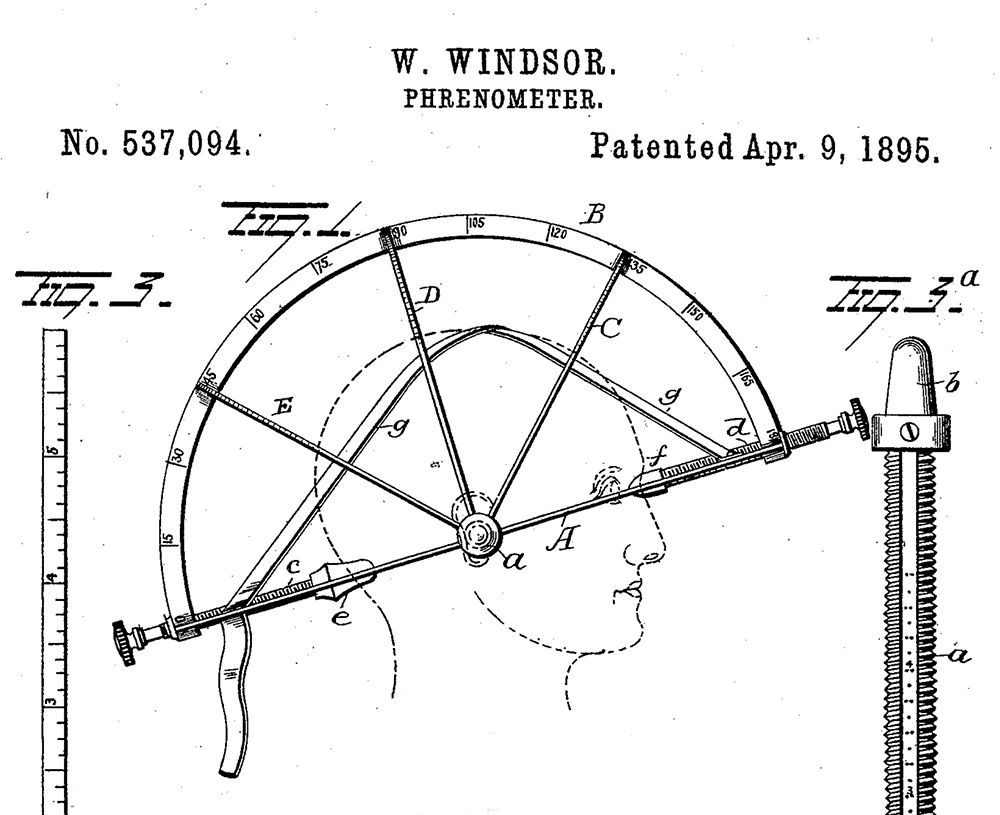
“By Kissing Another One Can Tell Whether a Person Is Carrot or Grapefruit.”

He did not confine his practice to personally measuring skull bumps from his office, and instead sought to create a franchise: a network of self-help gurus peddling dubious advice on diet, marital relationships, and career guidance under the brand name “Vitosophy.” Some of these ideas were shared by other free-thinkers of the period, and phrenologists mingled among socialists, psychics, snake oil salesmen, and suffragists. There is no bright line distinguishing genuine social innovators of the period from Victorian cranks.
From 1899 through 1913, Windsor ran advertisements in newspapers from Portland, Maine to Los Angeles, California, promoting his lecture tours or “Boston School of Vitosophy.” Vitosophy promised to teach adherents “How to be Become Rich,” “How to Cure Yourself and Others,” “The Philosophy of Vibration,” “Why I Love You,” and that “Newton’s Theory of Gravitation is Untrue!” Windsor maintained later in life that “osculation” (kissing) was the most reliable “if not necessarily the safest” method for classifying human traits, one supposes having found measuring skulls to be less enervating.
“I believe in Phrenology. I believe in it as a science; I believe in it as a philosophy; I believe in it as a religion.” — Windsor addressing the Institute of Phrenology alumni dinner, December 1893.

“Missouri People Eat Dirt”
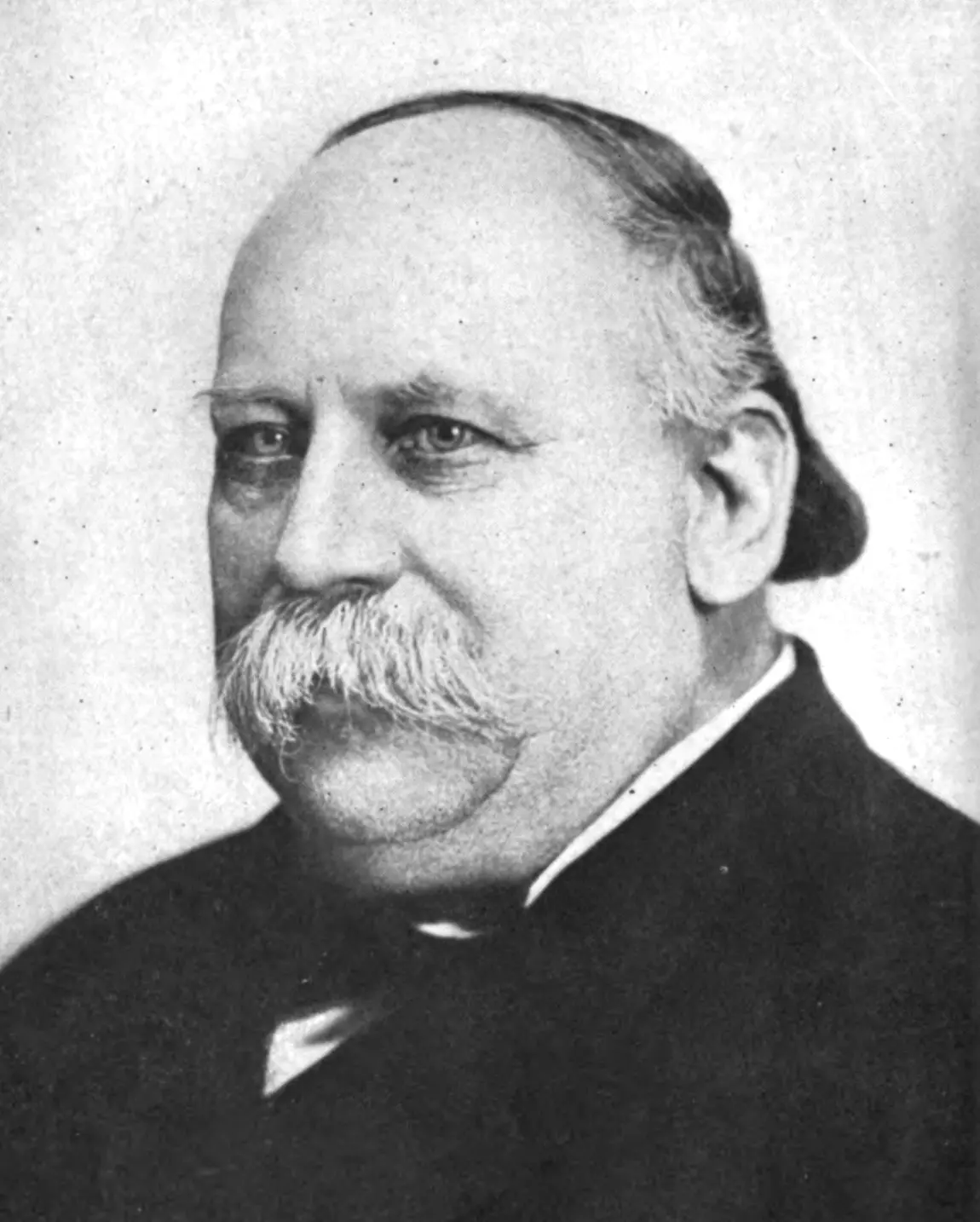
Windsor sold bags of allegedly sterilized sand for 25 cents each and encouraged his followers to eat it to aid digestion. “I wondered why men were not as healthy as animals,” he said, in an interview in 1901. “It occurred to me that men ate no dirt… Have a dirt sandwich with me?” At a vitosophy lecture in Ohio in 1906 an acolyte of Windsor’s was responsible for convulsions in dozens of audience members who ingested the black sand she distributed.
Windsor eventually stopped promoting dirt-eating but had at least two other run-ins with the law. In 1889 Windsor was lecturing in Arkansas when Little Rock police, acting under city council orders, demanded an operating license fee of ten dollars per week. Windsor refused and was duly arrested, found guilty, and fined. His team appealed, and prosecutors amended their charge to classify phrenology as “fortune-telling”, an activity subject to licensure by city law. To be exempt from the charge, the phrenologists only had to prove they did not attempt to predict the future. “We entered the courtroom fortified with skulls and callipers,” he wrote, and the jury agreed, at least, that they did not claim to be as clairvoyant as the men of Venus.
In February 1916, after complaints from customers unsatisfied with their phrenological readings, Pittsburgh police raided and closed Windsor’s head office, declaring “bump-reading” to be a “fake”, that the fake business nevertheless needed a license, and that furthermore “there was no such word as vitosophy.” (Windsor’s retort to the last charge was that the word was his own invention but also that “he does not know himself what it means.”) Windsor filed an injunction against the police which was denied, though within a few months the college was in operation again.
The many wives of Windsor
To the Beautiful, True, and Good Women who have appreciated my devotion to their sex, and who have cheered me with their smiles, encouraged me with their applause, delighted me with their companionship, and sustained me with their love: LOMA, the child of my brain, consecrated to the emancipation of woman from the enthrallment of Sex Slavery, presents an Affectionate Greeting. —Loma dedication page
Windsor and many other phrenologists took “free love” seriously, and in the 19th century the term usually meant freedom to move between monogamous partners based on emotional and physical attraction rather than lifetime bonds. Windsor was married four times, often to other phrenologists, divorcing partners who themselves had multiple marriages throughout their lives.
Elizabeth Augusta Foster (1860-1939)
Married 1879, when Windsor was 22 and Foster was 19.
Windsor’s first marriage was short-lived. He wed “Gussie” Foster in Indiana in July of 1879, while operating phrenology offices in both Gainesville, Texas and Wisconsin. Their first daughter, Bonnie, was born around the time of their marriage; their second, Allie, was born just before its dissolution. Elizabeth swiftly remarried in Gainesville, Texas and started a new family. Young Allie died age 6 and her sister, Bonnie Windsor, also had a brief life marked by tragedy.
Lilla Decedra Hatchet (1858-1934)
“Everybody has talents of some kind (except the idiots)”
Married c. 1890, when Windsor was 33 and Hatchet was 32. Divorced in 1892.
Lilla Hatchet was Windsor’s second wife, and a phrenologist in her own right who continued to use his surname professionally long after their brief marriage was dissolved. She was based in and around Gainesville, Texas, and it was here, with Windsor, that they formalized the commercial teaching practice that would bear his name. Together they exhibited skulls and measuring tools at the 1890 Texas State Fair. She had two sons from a previous marriage and cared deeply for a parrot that she claimed was fully bilingual in English and Spanish.
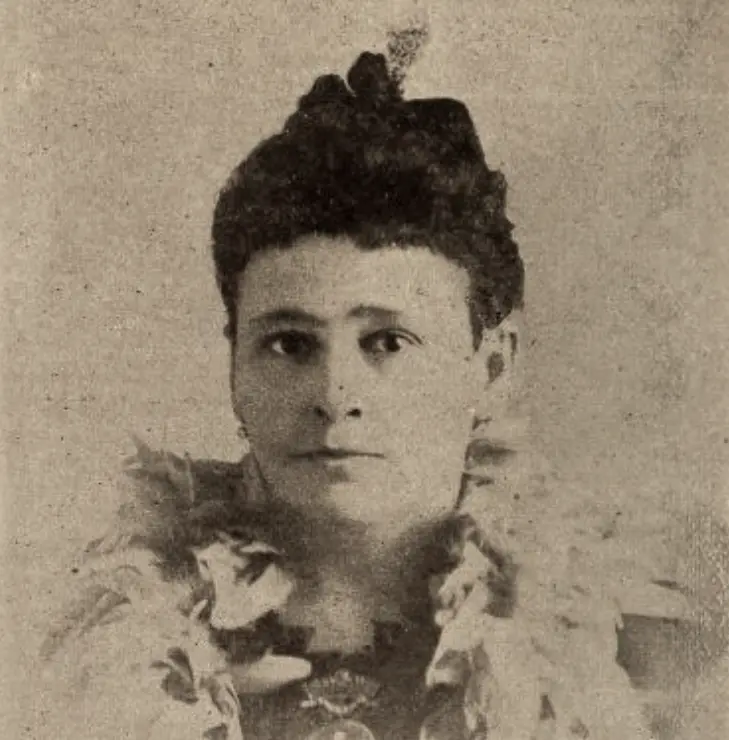
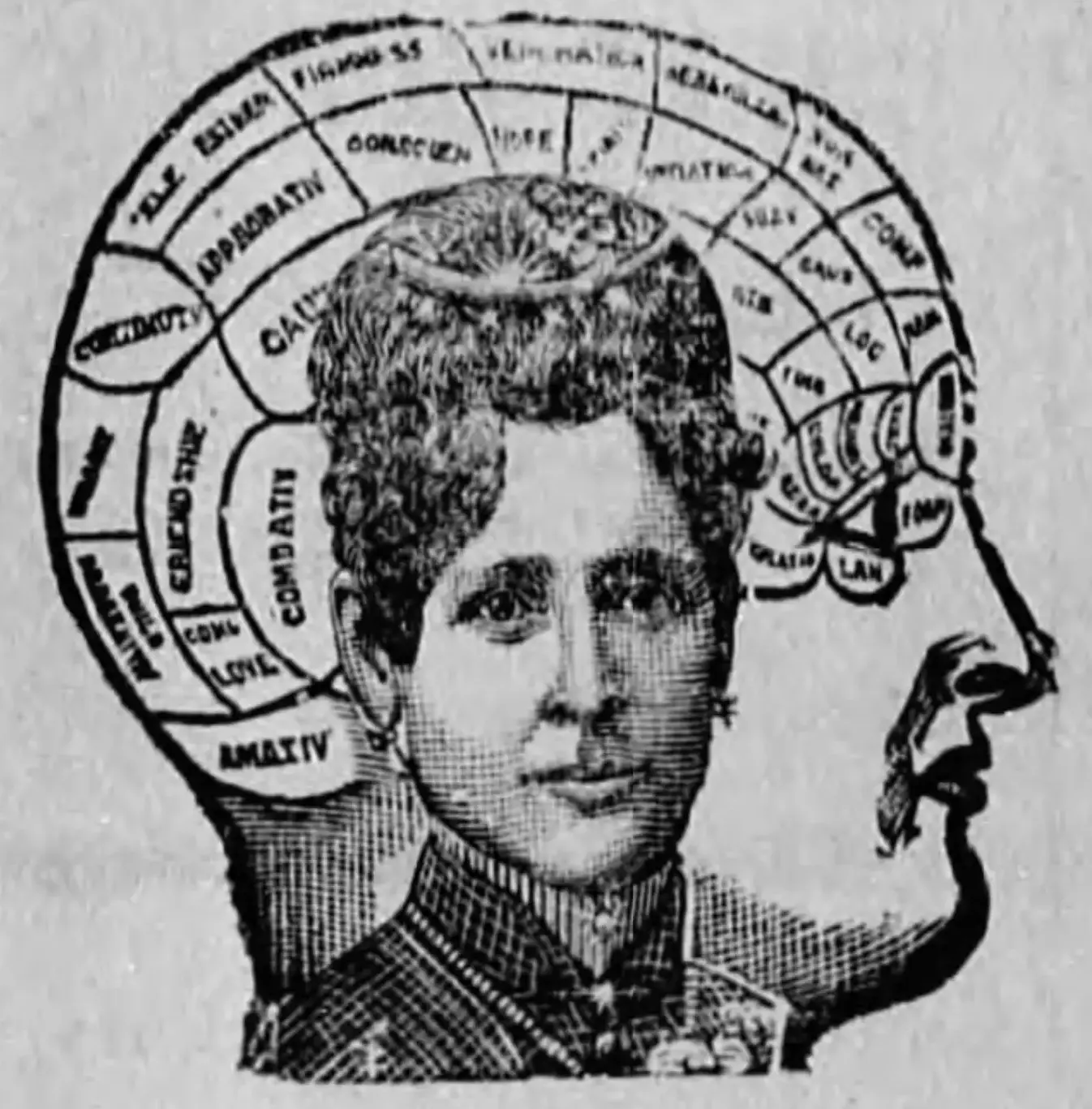
She styled herself “Madame Lilla D. Windsor M. S., Ph. D., M. D., Sc. D., the Queen of Phrenologists,” though she had no formal schooling beyond “The Windsor College of Phrenology” the pair founded in Washington D.C. (“Madame Windsor’s Scientific Museum” also in Washington was her solo creation: a collection of skulls including “reproductions of presidents, noted statesmen, murderers, and idiots.”) Once she and Windsor divorced, she continued to operate as the vice-president of the college for a time. As late as 1920 she was still actively traveling and lecturing from hotel rooms in various states, and around that time briefly married another phrenologist, Ira Ely. They divorced, and she fully retired to San Antonio to care for her 90-year old mother. At age 76 Lilla Windsor and her mother died together, of food poisoning.
“We must bow with admiration to the highest type of the Caucasian race, for here we have the talent that often shakes the world with its brilliancy and power.” — Lessons and Clippings from my Scrapbook (1896)
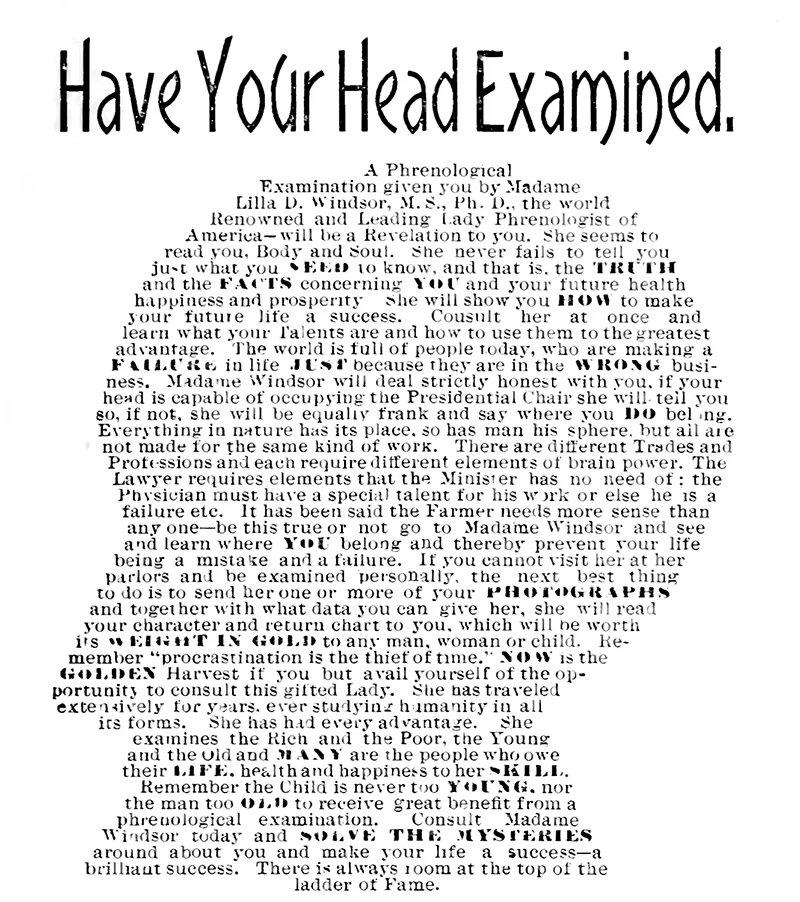
Millis “Bonnie” Marie Burnham (b. 1872)
Married 1897, when Windsor was 40 and Burnham was 25.
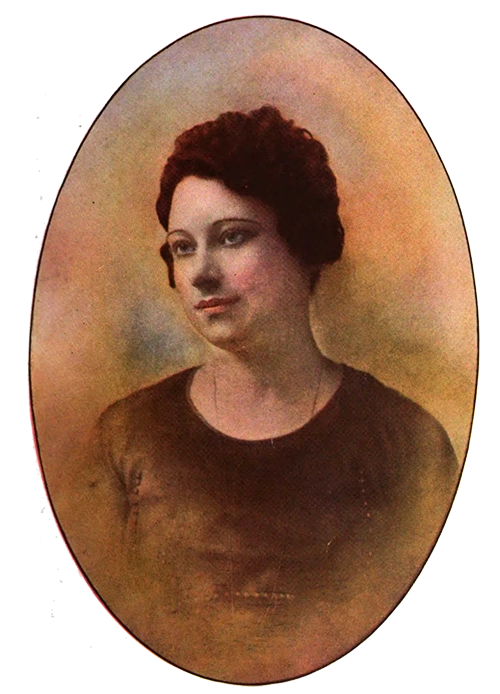
The pair married the same year he published Loma, and lived for awhile in her parents’ home in Schulyer, Illinois, though by 1902 they had relocated to Massachusetts. According to Bonnie Hoyt, Windsor’s daughter, Bonnie Burnham did not care for the girl, and the daughter became estranged. It’s unclear whether the marriage ended in death or divorce, but she is his only ex-wife to get a feature in Phrenology, the Science of Character (1921), published after Windsor married for the fourth and last time.
“The Grand Table of Vitosophy will after you have learned to use it, inform you that she is fond of the Water, has an exquisite sense of Touch, possesses the Magnetic temperament, that her Skin is very active insuring vigorous Depuration, the development of Purity and the promotion of Health. That she requires much Air, has a keen sense of Smell, the Acid temperament is preponderant and that this endows her with strong Lungs, vigorous Respiration, a keen appreciation of Beauty as expressed in music and art and a love of Harmony.”
Russell Haigh Tayman (b. 1879, d. after 1954)
Married 1919, when Windsor was 62 and Tayman was 40.

Tayman was also a practicing phrenologist; she listed an independent clinic in Pittsburg as early as 1917 and styled herself “Doctor.” They married in 1919 after she had been his assistant for many years.
This is his only wedding that received any public notice:
SAND EATER WRITES OWN WEDDING RITUAL
DIET CRANK ALSO HAS FREAK MARRIAGE IDEAS
- The Chanute Daily Tribune, Chanute, Kansas, Nov 7, 1919
Windsor’s “freak marriage ideas”—banning the use of “obey” in the ceremony and making the vows between man and wife reciprocal—would be familiar to any Venusian.
Tayman was deeply involved in Windsor’s empire by the time they married; she was vice-president of his organization (the same title once held by Lilla) and a frequent, if inept, illustrator for his written works. They often lectured together, giving separate talks to men and women. He credited her for developing a new phrenological term, applying to those who exhibited the novel trait of platonic attraction to the opposite sex: Sexamity. The term would appear on phrenological charts and devices by other practitioners.
Tayman remained active in Pittsburgh for a few years working in public health. By her seventies she had settled in the fringe spiritualist community of Lily Dale, New York, home to generations of mediums and psychics, as a lecturer and community leader.
Death and legacy
The word “eugenics” rarely appears in Windsor’s own writing, but he was a frequent contributor to eugenics clubs and publications. He wrote opinion pieces in Lucifer: The Light-Bearer, Moses Harmon’s anarchist publication that by 1907 bore the by-line “The Pioneer Advocate of Eugenics in America.” In 1903 Windsor claimed in that journal to have spent $3,000 to “produce my last baby by phrenological methods,” a curious boast given that his daughters were both deceased at a young age.
In 1921, Windsor and Tayman co-published Phrenology: The Science of Character and featured character profiles of famous people and family members alike. By this point, the pseudoscience had fallen out of fashion and the book attracted little notice, though he never stopped his lecture tours. “You see this skull?” Windsor asked a Nebraska newspaper reporter in November, 1922, holding human remains he claimed were from an impoverished Black woman. “One can easily tell that she lacked intelligence by the dimensions of the skull.”
William Windsor died a month after that interview, on December 21, 1922, of acute bronchitis in Milwaukee, Wisconsin at the age of 65. He lived to see phrenology fade into obscurity, but not to see the terror that eugenics would wreak on the world. The following summer, Tayman performed the “queer rites” of the memorial service Windsor had designed for himself, and spread his ashes over Lake Michigan, where Loma begins its story.
“I desire no monument,” Windsor wrote in his directives for his death. “If my writings survive, they are sufficient.”
References and further exploration
William Windsor chronology, assembled by the author on Ancestry.com.
“Bonehead Medicine in Texas.” Texas Co-op Power. Accessed October 16, 2022.
Sysling, Fenneke. “Science and Self-Assessment: Phrenological Charts 1840–1940.” The British Journal for the History of Science 51, no. 2 (June 2018): 261–80.
Tadajewski, Mark. “Character Analysis and Racism in Marketing Theory and Practice.” Marketing Theory 12, no. 4 (December 1, 2012): 485–508.
“William Windsor (Obituary).” Wisconsin Alumni Magazine 24, no. 4 (February 1923): 134–35.
Patent: Phrenometer, William Windsor. United States US537094A, issued April 9, 1895.
Windsor, William. How to Become Rich
Windsor, William. Loma, a Citizen of Venus. St. Paul, Minn.: Windsor and Lewis Publishing Co., 1897.
Windsor, William. Phrenology, the Science of Character. Big Rapids, Michigan: Ferris-Windsor Company, 1921.